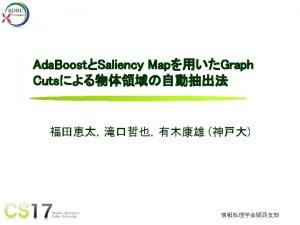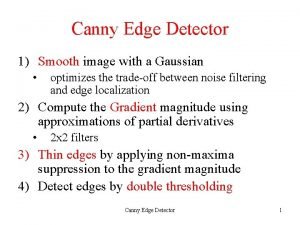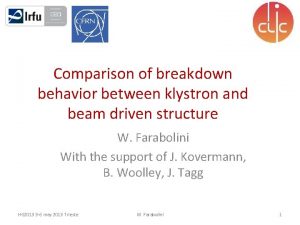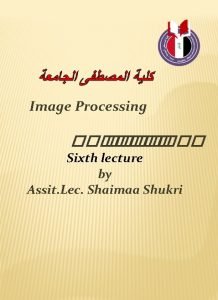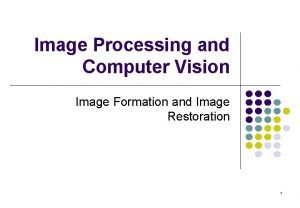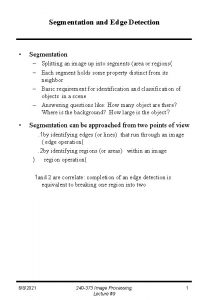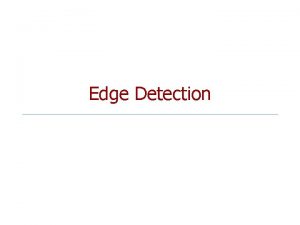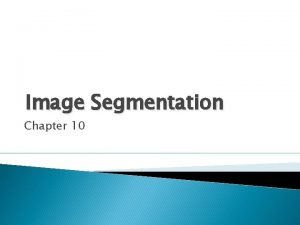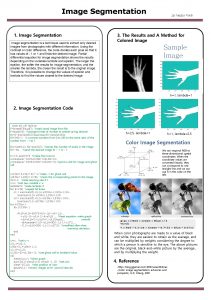Segmentation and Edge Detection Segmentation Splitting an image







- Slides: 7

Segmentation and Edge Detection • Segmentation – Splitting an image up into segments (area or regions( – Each segment holds some property distinct from its neighbor – Basic requirement for identification and classification of objects in a scene – Answering questions like: How many object are there? Where is the background? How large is the object? • Segmentation can be approached from two points of view. 1 by identifying edges (or lines) that run through an image ( edge operation(. 2 by identifying regions (or areas) within an image ) region operation( 1 and 2 are correlate: completion of an edge detection is equivalent to breaking one region into two 9/29/2020 240 -373 Image Processing, Lecture #9 1

Region Operations • Required to cover a substantial area of the scene rather than a small group of pixels Technique 1: Crude region detection USE: To reconsider an image as a set of regions. OPERATION: The regions are simply identified as continuous pixels of the same gray level. The boundaries of the regions are at the cracks between the pixels rather than at pixel positions. • This technique may give too many regions to be useful • bunching (quantizing) technique can be used to reduce number of regions 9/29/2020 240 -373 Image Processing, Lecture #9 2

Region Merging Technique 2: Region merging USE: To reduce the number of regions, to combine fragment regions, to determine which regions are really part of the same area. OPERATION : – Let s be a crack difference, i. e. the absolute difference in gray levels between two adjacent (above, below, left, or right) pixels – Then given a threshold value, T, we can identify for each crack i. e. w=1 if the crack is below the threshold (the regions are likely to be the same), or 0 if it is above threshold. – Measure the full length of the boundary of each of the regions that meets at the crack. These will be b 1 and b 2. – Sum the w’s that are along the length of the crack between the region and calculate – If this is greater than a further threshold, deduce that the two regions should be joined 9/29/2020 240 -373 Image Processing, Lecture #9 3

Region merging example If we make T=3, then all the cracks are significant Sum of w’s Region Boundary With A With B With C A 17 - 9 0 B 10 9 - 4 C 4 0 4 9/29/2020 240 -373 Image Processing, Lecture #9 - 4

Giving sum/min(b 1, b 2) for A, B, and C as follows: Region A B C A - 0. 9 0 B 0. 9 - 1. 0 C 0 1. 0 - – If we take threshold for combining as 0. 95, then B will be combined with C. – If the combining threshold is set lower, then A will also be combined giving the whole image as just one region. • The algorithm combines the small region (4) with the larger region (2), rather than the two larger regions (1 -2. ( • Size of the region can be used instead of the length of the region boundary. 9/29/2020 240 -373 Image Processing, Lecture #9 5

Region Splitting Technique 3: Region splitting USE: To subdivide part of an image into regions of similar type OPERATION : – Identify significant peaks in the gray-level histogram – Look in the valleys between the peaks for possible threshold values. – Find splits between the best peaks first LIMITATIONS: – This technique relies on the overall histogram (Multiple chessboards example( – Example *********** 0 **** 1 ***** 2 ********* 3 **** 4 9/29/2020 the valley is at 1 240 -373 Image Processing, Lecture #9 6

– Which side should the 1’s go? – Consider both options (2, 3, 4) , (0, 1)(1, 2, 3, 4) , (0) OOOOOO. O. . OOO. . . . O. O. . . . OO. . . . OOOOOO. O. . OOOOOOO. . . OO. O. . . OOO. . . . The second option less stragglers than the first but is is difficult to see this without trying it. COMMENT: – The histogram could just be of a region within the image – For color images, there are 3 histograms to choose from 9/29/2020 240 -373 Image Processing, Lecture #9 7
